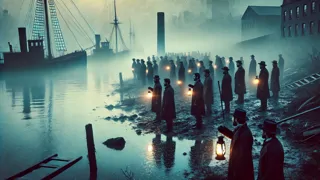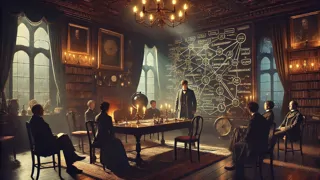Introduction
In the narrow, gaslit streets of 1842 New York City, a hush fell over the East River docks when the body of a young woman was discovered at dawn, slipping between the currents as ghostly as a fading dream. That woman, Marie Roget, had arrived from France just months earlier, carrying with her the gentle grace of the Seine and the quiet diligence of a seamstress determined to build a new life. Yet no mortal hand, it seemed, could stave off the violence that awaited her in this bustling metropolis. Word of the tragedy evaporated into the pages of the city’s broadsheets, which teemed with half-truths and sensationalist flourishes, each account drifting further from the sparse facts preserved in the coroner’s dossier. Into this storm of speculation stepped C. Auguste Dupin, the inveterate investigator whose gift for logic had already unraveled enigmas across Europe. Arriving from Paris in pursuit of clarity, Dupin surveyed the scene with a scholar’s eye: flotsam caught among the reeds, echoes of a cry carried on the morning fog, and the faintest imprint of disturbance on a muddy embankment. He observed the patterns of dockworkers’ footwear, the angle at which paper lanterns had swung, and the precise discoloration of floodwaters that tampered with nature’s timeline. With his remarkable blend of rational deduction and poetic intuition, Dupin intuited that Marie’s demise was not a random act of cruelty, but a calculated collision of human frailty and opportunism. In his solitary lodgings overlooking the misty harbor, he charted the contours of a tragedy yet to be fully understood, gathering newspaper clippings and witness reports as though they were the instruments of an orchestra waiting to play the final, revelatory note. Every discarded glove, every coded reference, and every silence between statements became a clue in the grand tapestry of her last hours. For Marie Roget, justice would depend on an uncompromising pursuit of truth, guided by a mind unafraid to pierce the shadows. It was in that charged space between rumor and reality that Dupin resolved to bring reason to bear, determined to disentangle the illusions that obscured the path to clarity and to restore dignity to a life cruelly torn away.
Discovery on the Hudson
At dawn on a crisp October morning in 1842, before Manhattan's tenements and taverns had filled with their usual bustle, a solitary crew aboard a modest tugboat noticed a pale shape drifting near the mud-flats of the Hudson River. The river, cloaked in an early mist that lent the water an eerie stillness, reflected the dim light of the rising sun with a muted glow. When Capt. Jeremiah Clark ordered his men to investigate, they found, half-submerged and lifeless, the body of a young woman. Her dark hair fanned out like drifting kelp across the surface, and her eyes, though closed, bore a haunting suggestion of unspoken terror. The men recoiled at the sight, their lanterns flickering in trembling hands as they hauled the corpse aboard. Word of the discovery spread swiftly, carried on the wind and in the shock-stricken cries of dockworkers and innkeepers alike. Within minutes, city watchmen arrived, followed by a growing throng of curious onlookers whose hushed whispers mingled with the clang of metal as an improvised stretcher was assembled. The panic deepened when an aged market vendor recognized a delicate locket clasped around the victim's neck, a tiny portrait encased in glass. Gathering closer, he uttered a single word that rippled through the crowd: 'Marie Roget.' In those solemn moments, as the caretaker of the body—a sombre cart—rolled toward the morgue, few realized they were witnessing the first chapter of a case that would baffle New York's finest minds and draw the attention of the world's most discerning detective.

Within hours of the grim discovery, Hiram Byrnes, the city coroner, convened a formal inquest in a cramped room above the municipal morgue, its walls lined with rows of whitewashed tiles that seemed to recoil at the sight of the unveiled corpse. The air was thick with the acrid smell of disinfectant and the uneasy shuffle of feet. Byrnes, a hardened official renowned for his blunt assessments, peered over circular spectacles and gingerly adjusted his tweezers as he began to record the first signs of trauma: a distinct laceration on the nape of the neck, subtle bruising around the ribs, and the telltale discoloration of waterborne immersion. Medical students leaned forward in silent fascination, notebooks buzzing as they jotted down every nuance. Yet for all the scientific precision, there remained glaring gaps: no definitive time of death could be determined beyond a twelve-hour window; the victim's fine gloves, mailed in from her distant birthplace in France, were nowhere to be found; and despite a thorough search of local docks, no footprints or bloodstains betrayed her last path ashore. Outside, a motley ensemble of reporters trailed the procession of evidence, hoisting cameras that screeched and shutter clicks that echoed down narrow streets. At a makeshift press stand in Lispenard Street, journalists chattered breathlessly about clandestine rendezvous, cross-Channel schemes, and avaricious landowners who might have silenced the seamstress to protect their own interests. In the corner, a clerk from the Steamboat Company whispered that a mysterious passenger had been noticed boarding the Catherine, bound for Albany, just days prior, a rumor unverified yet swallowed eagerly as fact. It was amid this swirl of speculation and half-truths that C. Auguste Dupin, having followed the coverage from his secluded Parisian lodgings, decided to cross the Atlantic once more. Something in the pattern of these contradictions spoke to his analytical instincts, and he sensed that uncovering the genuine sequence of events would require more than a simple reading of headline accounts.
As evening fell over the city, the morgue’s iron gates clanged shut, and the fragments of an official report were shuffled into an oak writing desk that belonged to Chief Inspector Thaddeus Grafton of the Metropolitan Police. It was there, under the glow of a single oil lamp, that Grafton examined the preliminary findings, his brow knotting with exasperation. Newspaper headlines clamored for swift justice, yet the absence of a definitive motive left him with little more than conjecture to offer. The notion of a solitary killer lurking in shadowy alleys stirred both dread and fascination among the populace, giving rise to nocturnal rumors of robed figures and hidden cults. Meanwhile, the muffled sobs of Madame Roget were recorded by a compassionate detective who visited her in the humble boarding house where her daughter had last been seen alive. She lay wrapped in blankets, her grief punctuated by soft, inconsolable moans, as she placed one fragile hand upon the wood of her daughter’s mirror, willing it to reflect the truth she so desperately sought. Back at the morgue, a northerly wind rattled the windows, carrying with it the distant clatter of wagons and the muted promise of winter frost. It was at that moment Dupin arrived in New York, stepping onto the fog-shrouded wharf with deliberate calm. Clad in a dark frock coat and with the faintest trace of a smile at the corner of his lips, he surveyed the gathering night, convinced that the unseen architecture of facts and falsehoods could be disentangled by a mind unbound by prejudice. Little did the city realize that the investigation had only just begun, and that the true measure of justice lay not in the speed of a verdict, but in the clarity of reason applied to the faintest of clues.
Clues in the City
In the days that followed the coroner's inquest, C. Auguste Dupin embarked on a meticulous exploration of every fragment left behind by the slain seamstress. With the discipline of a scholar and the keen eye of a detective, he revisited the cold banks of the Hudson, measuring tide lines and charting the precise point where the current had likely tumbled Marie Roget's body. He spoke with riverboat pilots who described the peculiar motion of a late-night schooner departing from North Cove, a vessel whose manifest, Dupin discovered in port records, included no passengers matching Marie's description. At the break of dawn, he scavenged the markets of Greenwich Village, inspecting baskets of fresh lilacs and noting the absence of petals on the muddy cobbles. Was the bouquet placed by an admirer, or carried by the victim herself? In a narrow alley adjacent to a shuttered boarding house, he found a cufflink scuffed by gravel, bearing the faint initials 'J.W.'—a clue scrawled into the earth by dust and circumstance. Through this painstaking reconstruction of Marie's final footsteps, Dupin sought to distill order from chaos, aware that human error so often masked the truth. By examining the direction of water lines on a discarded shawl and assessing the angle of bruising on her wristbones, he began forming a portrait of her final struggle, one that contradicted the sensational accounts printed by newspapers eager to fill column inches with fanciful speculation. Inside the modest parlor of Mrs. Caldwell's boarding house, where Marie had lodged under the name Madame Duval, Dupin studied the cuff of a garment stained with a peculiar rust-red hue. He observed the pattern of embroidery, cataloging each stitch and comparing it to similar motifs sold at a street fair weeks earlier. From the proprietor of a nearby tobacconist shop, he procured samples of clay pipes that bore the ledger marks of a merchant who kept detailed records of every sale; one entry listed a 'Marie R.' purchasing a parcel bound for Troy, New York, just four days before her death. Though the clerk was uncertain whether the initials corresponded to the Rogers or the Roget family, Dupin noted how such ambiguities could be weaponized by those seeking to hide in plain sight. He then turned his attention to the notebooks of Miss Clara Hughes, Marie's closest friend, who recounted the seamstress's fearful murmurs of footsteps echoing in empty corridors. Miss Hughes described a man whose gait suggested a limp—precisely the irregular pace Dupin had deduced from footprints found at two separate landing points along the riverbank. This union of forensic observation and personal testimony crystallized a working hypothesis: that the killer was not a stranger passing in the night, but someone known to Marie, confident she would not raise an alarm. Yet as he mapped these revelations onto a worn leather chart, Dupin felt the lingering presence of misdirection, a deliberate fog obscuring a darker intention.

As afternoon waned into evening, Dupin retreated to the crowded offices of The New York Herald, where hot press machines hummed beneath flaring gaslights and rumors circulated through the clacking typesetters like sparks across iron rails. He collected every scrap of reporting on Marie Roget's demise, from sensationalist pamphlets proclaiming a satanic ritual to sober editorials demanding swift justice. Each account bore the inevitable imprint of its author's preconceptions—some fixated on Marie's immigrant status, hinting at an underworld conspiracy; others portrayed her as the innocent victim of a jealous admirer. Rather than dismiss these retellings outright, Dupin scrutinized the inconsistencies: a witness who swore he saw her enter a coach at midnight had previously claimed no carriages were in service at that hour; a series of telegrams intercepted near the docks had been misdated, shifting the purported time of her disappearance by nearly five hours. By cross-referencing these details against official rosters of steamboat departures and the minute logs kept by harbor patrols, he methodically dismantled each hypothesis until only one credible narrative remained—a nocturnal meeting at a vacant warehouse off Centre Street. With a terse note to Inspector Grafton, Dupin recommended a targeted search of the building's cellar, where he suspected crucial evidence had been concealed. Although skeptical at first, the inspector could not ignore the rigid logic woven through every line of Dupin's reasoning, and soon a contingent of constables was dispatched to follow the trail that mere gossip had obscured. Inside that dimly lit warehouse, they discovered a small trunk, its lock hastily pried open, containing a torn journal bound in worn leather. The final entries, penned in Marie's delicate hand, alluded to a clandestine partnership with a man whose surname she did not fully record—a hesitation that perhaps saved his identity from immediate discovery. Alongside the journal lay a single glove, matching the pair worn by the victim in early witness sketches, and several slips of paper featuring the number 'XXVII' alongside crudely drawn maps of the East River docks. This convergence of personal confession and physical artifact confirmed what Dupin had long suspected: that Marie's death was neither random nor merely the result of drunken misadventure, but a calculated act intended to erase her ties to a clandestine liaison. Armed with this revelation, Dupin prepared to confront the key players in the drama, certain that the next move would unmask the shadowy figure who had woven such a tapestry of deceit.
With the torn journal and glove secured, Dupin convened an informal assembly within the oak-paneled study of a sympathetic reporter who had provided him with assistance. Spread across a scarred mahogany table lay each critical scrap of evidence: the bloodstained glove, the cryptic maps, and Marie's heartfelt confessions to a love that teetered between devotion and dread. As candlelight danced across his thoughtful face, Dupin traced the path from twisted map to stark reality, illustrating how the killer had lured Marie under the pretense of secrecy, then sealed her fate in the cellar beneath the seemingly innocuous warehouse. The reporter, pen poised above a fresh sheet of paper, recorded every syllable, acutely aware that this would be the most groundbreaking dispatch of his career. Yet Dupin cautioned caution, insisting that proof must precede publication, for the balance between revelation and ruin hung by the slenderest of moral threads. A misstep could condemn an innocent or allow a guilty man to disappear into anonymity. It was with this careful precision—scrutinizing motives as much as physical traces—that Dupin readied himself to confront the architect of Marie Roget's demise. In the labyrinth of lies and half-truths spun across the city, he had brought to light a singular truth: that the greatest malefactor seduces through familiarity, and one must look closest to one's own circle to find the darkest betrayal.
Dupin’s Analytical Revelation
In the pre-dawn hush of the following week, Dupin accompanied Chief Inspector Grafton and a detachment of constables to the deserted Centre Street warehouse that had sat dormant since the night of Marie's passing. Lanterns bobbed across the cracked pavement as the assembled officers pried open the great iron doors with solemn reverence, revealing the dusty interior where time itself seemed to have frozen. Beneath the slanted shafts of moonlight, crates labeled with foreign port destinations lay strewn across the floor, their canvases torn and mottled by moisture. It was there, behind a false partition sealed with rusted nails, that the constables unearthed two items of irrefutable significance: a single glove, torn and bearing traces of blood, and a leather-bound journal whose pages fluttered in the sudden draft. The glove, identical to the one discovered near Hudson's banks, still clutched the curve of a slender finger. The journal, opened to a trembling entry dated days before her untimely demise, betrayed Marie's fears of an unnamed associate whose jealousy had grown perilously fierce. Dupin examined each object with solemn care, his unhurried gestures masking the storm of insight gathering behind his steady gaze. A hush fell over the group as he tapped the journal's binding and noted the lingering imprint of a torn letter tucked between pages—one that omitted the closing signature but contained a phrase Dupin recognized from the numbered puzzles he had previously deciphered. The silent interplay between text and symbol affirmed his suspicion: this warehouse had served as a clandestine theater for a crime of passion, meticulously planned and coldly executed. As the constables carried the items to waiting carts, Dupin knelt beside a shallow pit beneath a timber beam, his fingers tracing the outline of a faint footprint pressed into crumbling plaster and gravel. The print revealed an uneven gait, heavier on the right heel, suggesting a limp or altered stride. He rose, his long coat brushing against the dirt-streaked floor, and uttered a single observation that turned heads: 'Our culprit is not only intimate with the victim but also intimately familiar with the ebb and flow of these streets.' Chief Inspector Grafton glanced at him quizzically, then at the journal, before nodding in solemn agreement. 'Then we must widen our inquiry within her circle,' the inspector murmured, his voice echoing among the shadows. Outside, the first streaks of dawn tinged the horizon with a pale glow, as though heralding the unraveling of a long-guarded secret. The trap, laid not with snares of steel but with the net of reason, was now set to ensnare the man who had thought himself both puppeteer and phantasmagoria in this tragic drama.

From the warehouse, Dupin escorted Grafton to the opulent parlor of a trusted acquaintance—an art patron whose salon often masked the clandestine dealings of New York's elite. There, beneath crimson draperies and gilded frames that depicted mythic heroes of justice, Dupin unfolded a large sheet of butcher paper onto a polished mahogany table. On it, he had sketched a precise timeline: the stroke of midnight when Marie departed her lodging, the clatter of distant hooves at the docks, the silent rendezvous at the warehouse, and the final lunge of violence before her body surrendered to the Hudson. Around this timeline, he wove each associative thread: the clay pipe held by an elderly boatman, inscribed with the initials 'J.W.'; the forged ticket that had allowed a clandestine passenger to board a steam vessel bound for Poughkeepsie; and the cryptic numeral 'XXVII' scrawled in Marie's diary, marking the twenty-seventh letter of a name never spoken aloud. He explained how an impassioned confession, recorded in tears and coded to protect the writer, served as the linchpin connecting these disparate elements. 'Observe,' he said, tapping the final entry, 'how the absence of a signature aligns with the missing glove, which our suspect discarded beneath this very floor.' His audience, rapt and silent, absorbed every syllable, recognizing the elegance with which Dupin had transformed rumor into revelation. Even at this refined gathering, where reputation was valued above moral obligation, the logic of evidence held sway. By midnight, a warrant had been drawn, bearing the name 'Jonathan Wilkes'—the proprietor of the clay pipe and the man whose limp gait matched the boot print at the warehouse. Wilkes, a respected shipping magnate who dazzled society with evening balls and philanthropic endowments, had woven a public persona that masked a capacity for possessiveness and menace. Dupin's methodical deconstruction of Wilkes's alibis and his intimate knowledge of Marie's routine exposed a man whose devotion veered into domination. As the warrant was sealed, each signature carried the weight of Dupin's meticulous scholarship, ensuring that the charge would rest not on conjecture but on unassailable proof. Thus, the quiet salons of high society became the unexpected backdrop for the final unmasking of a killer who had believed himself insulated by wealth and influence.
On a crisp morning that followed a night of quiet anticipation, the metropolitan court convened a hearing that attracted members of the press, dignitaries, and the trembling widow of Marie Roget. Chief Inspector Grafton presented the evidence with clinical detachment, while Dupin, seated prominently, observed the proceedings with an almost imperceptible nod. When Wilkes was led into the chamber, his gait gave away the limp that Dupin had documented, and the court murmured at the sight of the torn glove displayed atop the prosecutor's table. Testimony from riverboat captains confirmed his presence near the docks, logs from the steamship Catherine validated his opportunity to visit the warehouse, and the torn journal served as Marie's voice demanding acknowledgment. In a final moment of confrontation, Dupin was summoned to recite the chain of reasoning that had ensnared Wilkes in a web of inescapable deductions. His calm articulation, free of dramatics, underscored the precision of his logic: that motive, means, and opportunity converged unerringly upon this single individual. As the jury departed to deliberate, Madame Roget rose, her tear-streaked face flushing with relief and grief, thanking Dupin for granting her daughter's spirit the dignity of truth. Though the ultimate verdict would rest with twelve impassioned citizens, the intellectual victory belonged to Dupin, who had once again demonstrated that the architect of crime might be unmasked without recourse to violence, but through the patient unraveling of enigma. In that hushed chamber, he affirmed a principle that would echo through generations: justice is not merely found in outcome, but in the clarity of reason extended to the darkest of circumstances. As the court clerk banged the gavel and Wilkes was remanded to custody, Dupin slipped into the corridor, his silhouette momentarily framed by the light spilling through stained glass windows. He lingered long enough to observe the mixture of triumph and sorrow on Madame Roget's face, knowing that while the law might exact its due, the true solace for a grieving heart lay in the knowledge that no ruse or concealment could withstand the scrutiny of deliberate thought. With that, he turned his back on the courthouse, ready to embark on yet another venture where the faintest whisper of evidence demanded the illuminating touch of his intellect.
Conclusion
In unraveling the enigma of Marie Roget's tragic end, C. Auguste Dupin illuminated the shadowy intersections of motive, opportunity, and human passion. His journey led him from the mist-shrouded banks of the Hudson to the polished halls of high society, revealing how a criminal mind can cloak itself behind familiarity and finesse. Though the trial brought a semblance of closure through a formal conviction, Dupin understood that the true victory lay in preserving the integrity of truth against the tide of rumor and bias. The locket Marie wore and the final entries in her journal became silent witnesses to a life cut short and a justice painstakingly assembled from disparate fragments. In observing the intricate dance between perception and reality, Dupin reaffirmed a timeless principle: the pursuit of justice demands not only the strength of law but the clarity of reason. As the city turned its page on this haunting chapter, the detective departed into the gathering dusk, his mind already tracing the outlines of another mystery waiting in the fog. Marie Roget's story, though born of sorrow, will persist as a testament to the power of observation—and to the enduring belief that clarity can emerge from the darkest depths of deceit.


















